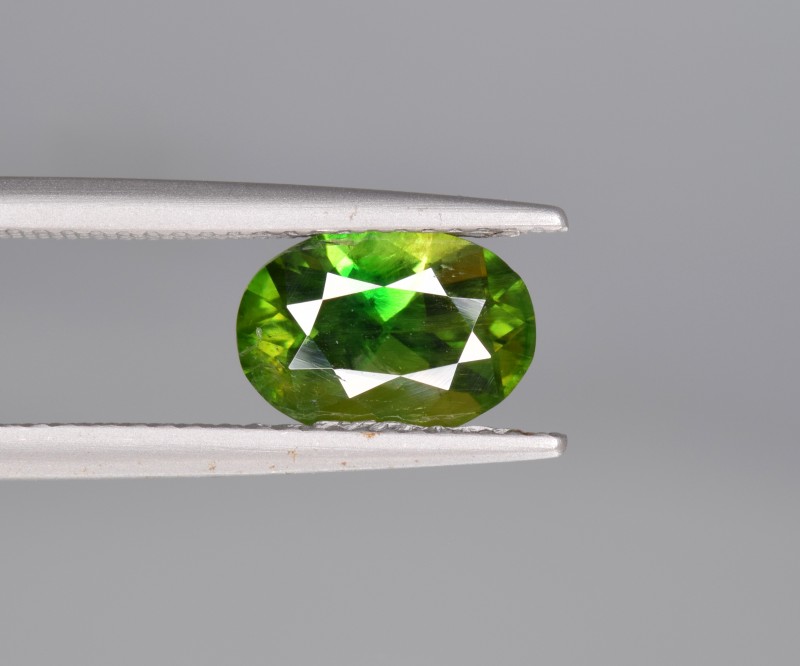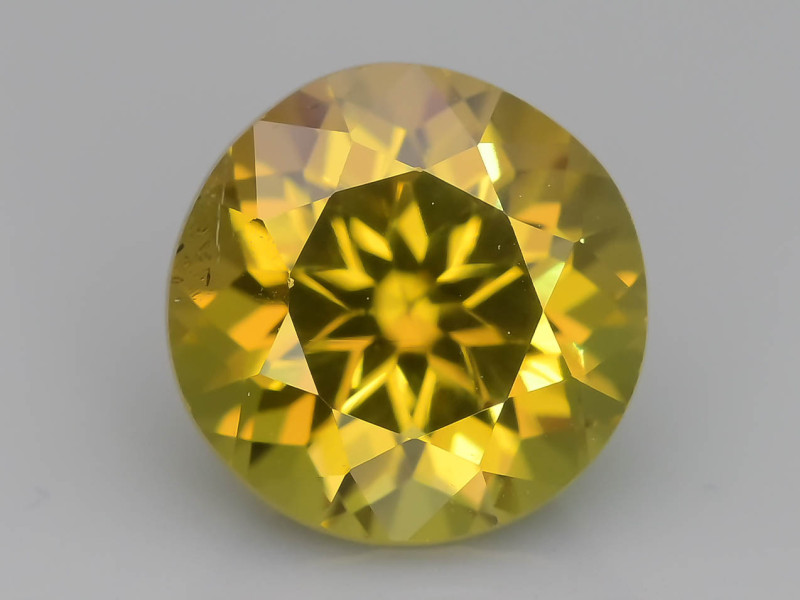
Andradite Gemstone: Properties, Meanings, Value & More
 The crème de la crème of garnet species, andradite occurs in a dazzling array of hues, from deep green to fiery orange.
The crème de la crème of garnet species, andradite occurs in a dazzling array of hues, from deep green to fiery orange.
Andradite is a rare gemstone prized by mineral collectors and crystal enthusiasts alike.
A stone of higher thinking and self-empowerment, andradite is more than visually stunning. This gem is believed to have a powerful impact on your physical, mental, and spiritual well-being.
Curious to learn more about this rare and cherished garnet? Today, we’re exploring the history, properties, uses, and all there is to know about andradite.

About Andradite Stone
Firstly, what does the name ‘andradite’ mean?
Andradite was named after Brazilian mineralogist José Bonifácio de Andrada e Silva, credited with the mineral’s discovery — but more on that later.
Since andradite is a garnet, you can use this gem as a:
Zodiac stone for supporting the Aquarius, Capricorn, and Scorpio signs in astrology.
Wedding anniversary stone for celebrating two years of marital bliss.
Switching gears, let's take a look at the mineral traits that make andradite a unique member of the garnet family.
Andradite Specifications & Characteristics
Andradite is the final member of the ugrandite garnet series, a group of calcium-iron garnets consisting of andradite, grossular, and uvarovite garnets. This series includes some of the most valuable and prized garnets and provides clues about the history of the rock they're found in.
The andradite formula is Ca3Fe3+2(SiO4)3, representing its chemical composition of calcium, iron, silicon, and oxygen. This chemical composition gives andradite unique physical and optical properties, like its high refractive index and durability.
Here’s an overview of andradite’s mineral data:
Mohs hardness: 6.5 to 7.5
Color: Yellow, greenish-yellow to emerald-green, dark green; brown, brownish-red, brownish-yellow; gray to black; sometimes sectored
Crystal structure: Isometric/cubic
Luster: Vitreous, resinous, or near-adamantine
Transparency: Transparent to translucent
Refractive index: 1.88 to 1.91
Density: 3.70 to 4.10
Fracture: Conchoidal to uneven
Tenacity: Brittle
Streak: White
Treatments: Heat (to enhance color)
Types of Andradite
Although andradite is a type of garnet, it also encompasses a range of distinct varieties, each with its own characteristics:
Colophonite
A brown, red, or orange granular variety with a resinous, amber-like luster.
Demantoid

The most sought-after andradite variety; ranges from emerald-green to green.
Melanite
 Image credit: Rob Lavinsky, iRocks.com – CC-BY-SA-3.0
Image credit: Rob Lavinsky, iRocks.com – CC-BY-SA-3.0
Curious what black andradite is called? Meet melanite, a lustrous black opaque variety.
Rainbow Garnet

Iridescent form of andradite; the least well-known variety.
Topazolite

Rarest andradite variety; occurs in lemon-yellow to yellowish-green similar to topaz.
Mali Garnet

Mali garnets are a combination of andradite and grossular only found in Mali. These rare garnets have yellow to green coloring and some are color-changing from grayish-green to brown. They're harder and more wearable than most andradites.
Phew! That’s a lot of andradites. Ready for history?
Andradite History
Andradite was named by American geoscientist James Dwight Dana in 1868.
As mentioned, the mineral’s moniker pays homage to its discoverer, J.B. d’Andrada e Silva, who uncovered the mineral while exploring diamond and gold mines in Minas Gerais, Brazil, in the early 19th century.
Throughout history, garnets were highly valued for their beauty and symbolism.
For instance, the ancient Greeks saw garnets as tokens of passion and devotion, while the first Anglo-Saxons adorned weaponry with these gems. Some royal figures even dropped garnets into wine glasses to ward off poison attacks.
Andradinites, in particular, have had a range of historical uses, including:
Jewelry and decorative ornaments
Refractory materials (furnace linings and high-temperature ceramics)
Abrasives (sandpaper and grinding wheels)
Metaphysically, what is andradite used for?

Andradite Healing Properties
Like other gems, including garnets, andradites make powerful healing stones for enhancing your mind, body, and soul.
Physical Healing
Physically, andradite strengthens the immune system, encourages blood stimulation, and boosts mineral assimilation.
Andradite may also promote bone health, boost energy and vitality, and support wound healing.
Emotional Healing
Many healers associate andradite with personal development and empowerment. It may inspire emotional strength, stability, and self-confidence, helping you rely less on external validation and trust your intuition.
Andradite may also be a powerful aid for overcoming feelings of victimization, addiction, or suicidal thoughts, providing support and protection during times of difficulty and transition.
Chakra Healing
You can also use andradite as a chakra stone for balancing your root chakra, located at the base of your spine.
This energy point is your hub of grounding, stability, and security. Andradite stabilizes your root chakra, improving your connection to the physical world, as well as your ability to feel safe and secure in your environment.

Andradite Gemstone Properties
Like most gems, andradite is graded based on color, cut, clarity, and carat weight.
Color
Andradite boasts a dispersion surpassing all other garnets, rivaling even diamonds.
This gem occurs in various colors, such as green, yellowish-green, yellow, brown (most common), brownish-red, and black.
Andradite’s highest-valued hues are the emerald-like greens of demantoid (caused by the presence of chromium and iron) and black melanite (caused by titanium and iron).
Cut
Most andradite gems are faceted into different gemstone shapes, particularly the demantoid variety.
Cabochon-style andradites are less common, but you can still find them on the market.
You’ll also find rough (or uncut) andradite for sale. This is the most affordable form, though exceptional specimens can still garner high prices.
 Pictured above: Demantoid garnet with horsetail inclusions
Pictured above: Demantoid garnet with horsetail inclusions
Clarity
Many andradites exhibit high brilliance and demantoids can display a unique form of fire caused by "horsetail inclusions” which are asbestos fibers within their structure. This phenomenon is so prized that lapidaries often facet stones to showcase them better.
Andradites have a Type II colored gemstone clarity grade. They may also receive a more specific clarity grade ranging from "eye-clean," meaning there are no visible inclusions or blemishes visible to the naked eye, to "included," meaning there are visible flaws that may affect the stone's transparency or overall appearance.
Visibly-included andradite may be less desirable or valuable than gems that aren’t, particularly if the inclusions affect the stone's transparency or overall appearance. Some, like horsetail inclusions, can increase the stone's value and desirability, as they’re considered rare.
Carat Weight
The typical size range for andradite varies according to its variety and locality.
Demantoids, for example, range from less than 0.1 carats up to several carats or more, with larger stones being rare.
Melanite, however, is typically larger, ranging from a few carats up to several hundred carats in size.
Generally, larger andradites are rarer and more valuable than smaller ones, all other factors being equal.
Moving on, what type of rock is andradite?

Andradite Formation & Sources
Andradite typically forms in high-temperature, high-pressure environments, like metamorphic or igneous rocks.
What is the temperature of andradite? This mineral requires around 1292°-2372°F (700°-1300°C) and pressures of several kilobars to form.
However, andradite can form via several processes, including contact metamorphism, regional metamorphism, and hydrothermal alteration.
Geographically, where is andradite found?
Mining Locations
The semi-precious gemstone is a prominent mineral found in several areas throughout Pennsylvania, USA.
The largest, most well-known deposit of andradite is in Cornwall, Pennsylvania, where the mineral is associated with magnetite and hematite.
Other notable localities include:
Afghanistan
Australia
Canada
China
Democratic Republic of the Congo
Greenland
Iran
Italy
Japan
Mali
Mexico
Namibia
Norway
Pakistan
Peru
Russia
South Africa
South Korea
Sri Lanka
Sweden
Turkey
Uganda
Yemen
Zimbabwe

Andradite Price & Value
Andradites are generally considered to be among the rarer and more valuable types of garnets. Here’s an overview of what you can expect price-wise:
Faceted andradite: Around $100 per carat for lower quality stones up to several thousand dollars per carat for top-quality gems with exceptional color, clarity, and cut.
Cabochons: Around $10 per carat for lower-quality stones, up to a few hundred dollars per carat for top-quality cabochons.
Rough andradite: Typically sold by weight rather than by carat, with prices ranging from a few dollars per gram for lower-quality stones up to several hundred dollars per gram for top-quality specimens.
Jewelry: From a few hundred dollars up to several thousand dollars or more, depending on the materials used and stone quality.
Caring for your gemstones will preserve their natural beauty for a lifetime of enjoyment.
Andradite Care and Maintenance
To clean your andradite, use warm water, mild detergent, and a soft brush. Gently scrub away grime and dry with a soft cloth. Then, store your gem in a cool, dry place away from harder gems and materials.
Keep your andradite away from:
Ultrasonic cleaners or steamers
High heat and extreme temperature changes
Prolonged UV exposure
Harsh chemicals and detergents
Since some andradites are more susceptible to scratching, opt for jewelry with protective settings and avoid wearing them during rigorous activity.
Stick to these guidelines, and your andradite will sparkle and shine for years to come.

Spark Your Inner Fire with Andradite!
Andradite truly lives up to its reputation as a unique and cherished garnet. Its dazzling color variations and impressive optical properties perfectly parallel its metaphysical superpower. This rare, dynamic gem is a true feast for the senses, captivating both the eye and the soul.
Ready to experience the transformative allure of andradite for yourself?
Search the Gemstone Encyclopedia
Related Auctions
Related Articles
Originally the Birthstones or gemstones were associated with a zodiac sign or the month of a individuals birth. Find out what your stone is and view the stones we have for sale
8th Feb 2021
There are dozens of quartz and chalcedony gems with various colors and patterns. Learn all about quartz properties and every type of quartz, from amethyst and agate to plasma and phantom quartz!
15th Oct 2020
Hackmanite is a pink to violet sodalite gem known for its unique color-change and luminescence. Learn why hackmanite is special, from its rare qualities to the types of hackmanite jewelry available.
28th Mar 2018
Latest Articles
Catapleiite is a lesser-known mineral and rare gemstone often found as stunning tabular rosettes near other rare stones. Discover the history, prices, benefits, and properties of catapleiite!
28th Apr 2025
Yugawaralite is a rare colorless, white, or pinkish zeolite crystal named for its discovery in Yugawara, Japan. Here we uncover the multifaceted history, properties, prices, and uses of yugawaralite.
24th Mar 2025
Simpsonite is a lesser-known mineral known on the gem market for its durability, yellow-orange color, and rarity. Discover all the properties, uses, prices, and history of simpsonite.
3rd Mar 2025
Article Categories
How To's is where you will find helpful articles from gem Rock Auctions on how to cut gemstones, select gemstones and buy gemstones.
9 Articles




